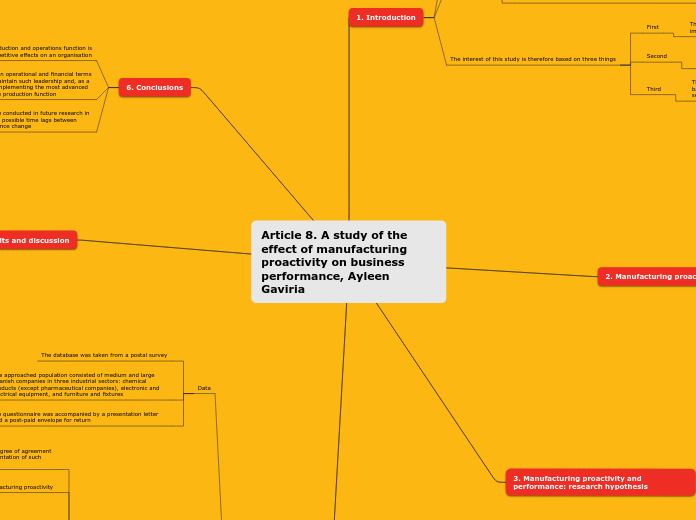Article 8. A study of the effect of manufacturing proactivity on business performance, Ayleen Gaviria
1. Introduction
The success of manufacturers depends on capabilities derivaded on failures and imperfections
The objective
It is analyse the role of this manufacturing proactivity
Understand the tendency of the company to reproduce the most advanced and promising production management practices
The interest of this study is therefore based on three things
First
The paper explores the behavioural dimensions underlying the implementation of advanced production practices
Second
This paper raises different causal explanations of the relationship between manufacturing proactivity and performance
Third
This research combines subjective measures of performance based on perceptions with objective data obtained from secondary sources.
2. Manufacturing proactivity
is defined as “the tendency of an organisation to implement all those practices, tools or management systems considered the most advanced, modern and promising within its production and operations function”
Acccording to ward, there are two dimensions
the degree of involvement of manufacturing in the strategic processes of the business unit
the degree of commitment to a long-term programme of investments in manufacturing structure and infrastructure aimed at building capabilities in anticipation of their need.
3. Manufacturing proactivity and performance: research hypothesis
Is undertood as the business performance, in some inoperational terms(quality, cost, flexibility, reliability, or speed) as well as in financial terms (profit and returns)
There are two reasoning
Advanced manufacturing practices and business performance
It is through the literature
The implementation of innovative work practices
include employee training
employee participation
involvement through problem-solving teams
Manufacturing proactivity, involvement of the production function in strategic processes, and alignment between production capabilities and strategic objectives
Hayes and Wheelwright (1984) distinguish four stages in the evolution of manufacturing’s strategic role
In stage I, internally neutral, the production function is considered as a necessary burden that is difficult to change
In stage II, externally neutral, some modifications are introduced in the production function in order to, at least, not harm the business strategy
In stage III, internally supportive, a production strategy is developed in order to support the business strategy
In stage IV, externally supportive, the production function constitutes a fundamental mainstay of the business strategy and is involved in major strategic decisions topic
Those companies showing a higher degree of production proactivity are probably in stage IV or close to this stage. In fact, in what can be interpreted as production proactivity
6. Conclusions
The empowerment of the production and operations function is intuited to have positive competitive effects on an organisation
Better business performance in operational and financial terms might generate a desire to maintain such leadership and, as a consequence, an interest in implementing the most advanced and promising practices in the production function
Longitudinal studies should be conducted in future research in order to take into account the possible time lags between implementation and performance change
5. Results and discussion
The integration of two important variables: cultural proactivity andtechnical proactivity
This result indicates that the implementation of tools and techniques such as JIT, CAD/CAM or integrated information systems affects the perceived performance interms of quality, reliability and flexibility
4. Methodology
Data
The database was taken from a postal survey
The approached population consisted of medium and large Spanish companies in three industrial sectors: chemical products (except pharmaceutical companies), electronic and electrical equipment, and furniture and fixtures
the questionnaire was accompanied by a presentation letter and a post-paid envelope for return
Measures
Manufacturing proactivity
each company was asked to choose their degree of agreement with ten assertions referring to the implementation of such practices
The underlying manufacturing proactivity
It was performed, which capture 49.498 percent of the variance
In the Varimax orthogonal rotation
The first factor
It measures a cultural dimension of manufacturing proactivity
It implies a greater cultural change within the organisation and a high score on this factor means
that the company thinks of employees as resources instead of costs, considers their suppliers as collaborators rather than competitors, and promotes dynamism and continuous improvement
The second factor
It measures a technical dimension
mainly takes in practices that involve the adoption of concrete tools or techniques in the production plant as
CAD/CAM systems
integrated information systems
advanced manufacturing technologies
JIT systems characterises those companies with high scores on factor 2
Performance
Managers marked on a five-point scale whether they considered their companies very inferior
Very inferior
Somewhat inferior
Equivalent
Somewhat superior
Very superior
Analysis
Four control dimensions were added to the group of independent variables
Company size – measured as hundreds of employees
Plant equipment age – measured by the number of five-year intervals from the acquisition of the main productive equipment in use
Company internationalisation – included by using a binary variable distinguishing those companies which are part of multinational groups
The companies belonging to international groups tend to be the larger and more proactive companies
The industrial sector – which required the introduction of two binary variables distinguishing the chemical and electronic and electrical equipment sectors, respectively
The electronic sector concentrates the largest companies with the newest equipment and the highest levels of technical proactivity
